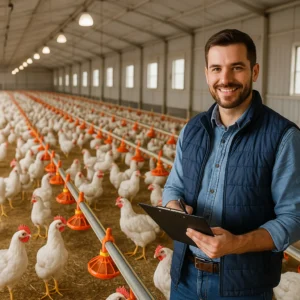Poultry farming has become one of the most profitable agribusinesses in the world. With a rising demand for eggs and meat, starting a poultry farming business in 2025 can be a great way to earn sustainable income—even on a small piece of land.
Whether you are a complete beginner or looking to scale your farm, this guide will walk you through everything you need to know to build a successful poultry business.
1. Choose Your Poultry Type
There are several types of poultry you can raise, but beginners should start with:
-
Broilers – Raised for meat. Ready for market in 5–7 weeks.
-
Layers – Raised for eggs. Start laying at 18–20 weeks.
-
Dual-purpose breeds – Good for both eggs and meat (e.g., Rhode Island Red).
Choose your poultry type based on your target market and budget.
2. Select a Suitable Location
For a small to medium poultry farm:
-
Choose a well-ventilated area away from residential zones
-
Make sure clean water and electricity are available
-
Ensure proper drainage to avoid infections
Tip: Avoid waterlogged areas to prevent disease outbreaks.
️ 3. Construct the Poultry Shed
A well-designed poultry house can reduce mortality and increase productivity.
Basic requirements:
-
East–west orientation for good airflow
-
Proper insulation (temperature control)
-
Nesting boxes and perches for layers
-
2 to 3 square feet per bird for broilers
️ 4. Feeding and Nutrition
Balanced and clean feed is critical to poultry growth.
Broiler Feed Types:
-
Starter feed: 0–2 weeks
-
Grower feed: 3–4 weeks
-
Finisher feed: 5+ weeks
Layer Feed: Requires calcium-rich feed for strong eggshells
✅ Always provide clean drinking water. Add vitamins/electrolytes in hot seasons.
5. Vaccination and Health Management
Disease prevention is key to poultry farming success.
Common Vaccines:
-
Newcastle Disease
-
Gumboro
-
Fowl Pox
-
Marek’s Disease
Use clean equipment and maintain strict biosecurity on your farm. Isolate new or sick birds immediately.
6. Cost Estimation & Profit Potential
Here’s a sample cost breakdown for a 500-bird broiler farm:
| Expense | Approx. Cost (USD) |
|---|---|
| Chick Purchase | $250 |
| Feed | $750 |
| Housing | $300 |
| Medication | $100 |
| Labor & Utilities | $150 |
| Total Investment | $1,550 |
| Expected Return (after 6-7 weeks) | $2,200–$2,500 |
Estimated Profit: $650–$950 per batch (6–7 weeks)
7. Marketing Your Poultry Products
You can sell:
-
Live birds
-
Dressed meat
-
Eggs (fresh or tray-packed)
Market options:
-
Local meat shops
-
Wholesale dealers
-
Hotels & restaurants
-
Online platforms (if available)
Build customer trust by maintaining hygiene and quality.
❓ FAQs
Q: How much land is required to start poultry farming?
A: For 500 broilers, around 1000–1500 square feet is sufficient.
Q: Can I start poultry farming at home?
A: Yes, small-scale poultry farming can be done at home with proper care and hygiene.
Q: Is poultry farming risky?
A: Like any business, it has risks—especially disease outbreaks. Good management reduces risk.
Conclusion
Starting a poultry farming business in 2025 is both profitable and scalable. With the right planning, management, and dedication, even a beginner can turn a small investment into a sustainable income source.
Whether you’re in a rural area or on the outskirts of a town, poultry farming can change your life. Start small, grow smart, and focus on quality!



